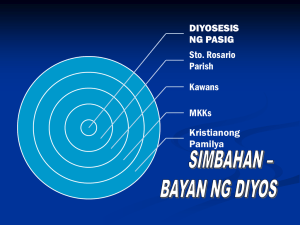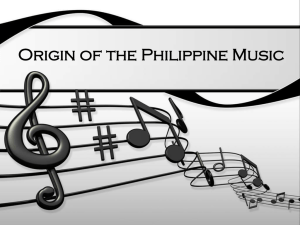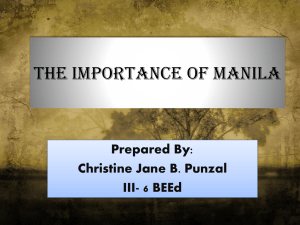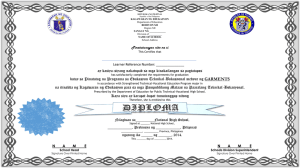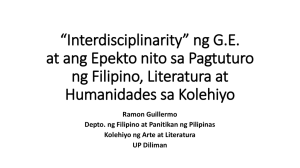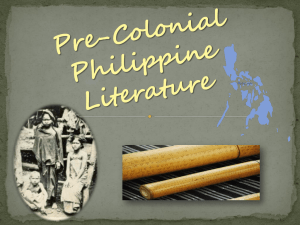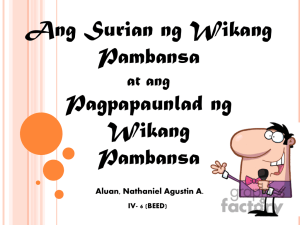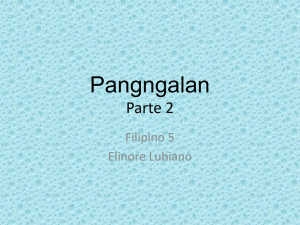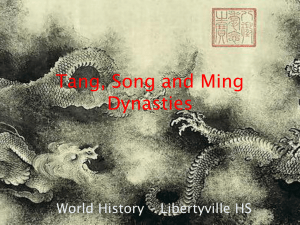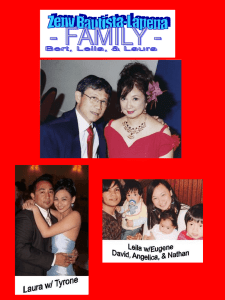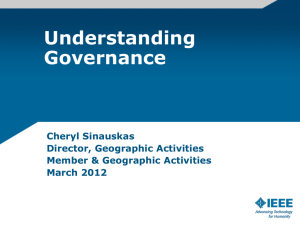Bersyon 1 - International Conference on Language
advertisement
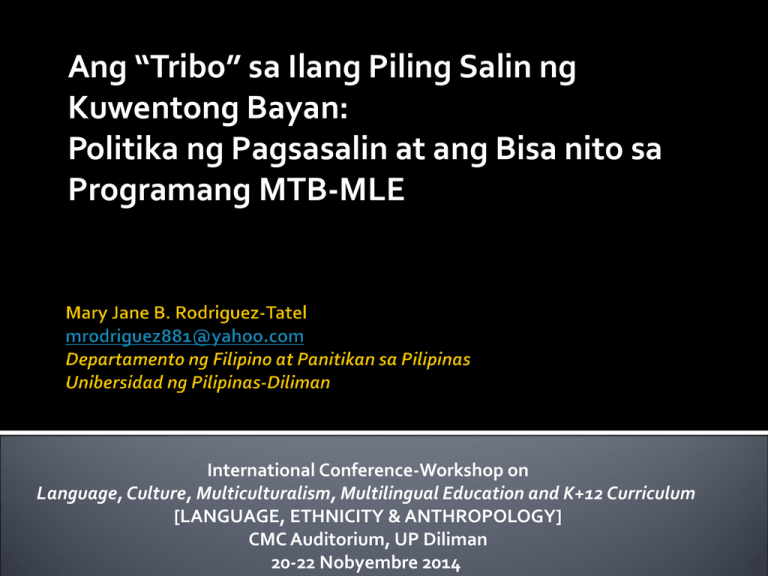
Ang “Tribo” sa Ilang Piling Salin ng Kuwentong Bayan: Politika ng Pagsasalin at ang Bisa nito sa Programang MTB-MLE International Conference-Workshop on Language, Culture, Multiculturalism, Multilingual Education and K+12 Curriculum [LANGUAGE, ETHNICITY & ANTHROPOLOGY] CMC Auditorium, UP Diliman 20-22 Nobyembre 2014 (1) papel at gamit ng kuwentong bayan sa paglikha ng kolonyal na diskurso ng “tribo”: Paano kinasangkapan ang mga kuwentong bayan sa pagkontrol sa mga sakop? (2) papel ng kultura sa proseso ng pagsasalin: Paano nakikipagtalaban ang mga kolonyal na bersyon sa kontemporaryong bersyon ng mga Pilipinong iskolar? Inaalingawngaw lamang ba ng bersyong Pilipino ang mga bersyong kolonyal? O hinahamon ang mga ito upang lumikha ng isang kontra-diskurso? (3). papel ng wika sa usapin ng paggigiit ng kultura at identidad. Ano ang bisa o implikasyon ng “kultural na pagsasalin” sa edukasyong base-sa -inang wika (MTB) at vice versa? National Cultural Minorities (1957-1975) No-Cristiano Infiel/Pagano at Moro (Panahong Espanyol) Non-Christian Filipinos (1935-1957) Tribal Filipinos/ ICCs (1987-1997) (IPs) Indigenous Peoples (1997kasalukuyan) Luzon/Visayas Mindanao-Sulu Lumad Muslim 1. Aeta 1. Ata or Ataas 1. Badjaw 2. Apayaw o Isneg 2. Bagobo & Guiangga 2. Maguindanao 3. Mangyan 3. Mamanwa 3. Iranun, Ilanun 4. Bontok 4. Mangguangan 4. Kalibugan 5. Dumagat 5. Mandaya 5. Maranao 6. Ifugao 6. Banwa-on 6. Pullun Mapun 7. Ilongot 7. Bla’an 7. Samal 8. Inibaloi, Ibaloi 8. Bukidnon 8. Sangil 9. Kalinga 9. Dulangan 9. Tausug 10. Kankanai 10. Kalagan 11. Molbuganon 11. Kulaman 12. Palawanon 12. Manobo 13. Batak 13. Subanon 14. Remontado 14. Tagabili 15. Sulod/ Bukidnon 15. Tagakaolo 16. Tagbanua 16. Talaandig 17. Tinggian o Itneg 17. Tiruray 18. Yogad 10. Yakan Batis: B.R. Rodil, 2004. The Minoritization of the Indigenous Communities of Mindanao & the Sulu Archipelago. Davao City: Alternate Forum for Research in Mindanao, Inc. & B.R. Rodil. NOON: “NON-CHRISTIAN TRIBES” The Non-Christians …are divided into numerous tribes, each with its distinct language and its peculiar customs. Some of them are pacific and gentle in the extreme, while others are very warlike (Dean Worcester, Sec of the Interior Dept., 1905). NGAYON: “INDIGEOUS PEOPLES” “…a group of people ...who have, under claims of ownership since time immemorial, occupied, possessed and utilized such territories, sharing common bonds of language, customs, traditions and other distinctive cultural traits, or who have, through resistance to political, social and cultural inroads of colonization, nonindigenous religions and cultures, become historically differentiated from the majority of the Filipinos (NCIP 2012-2013). NOON: “…small tribes of ‘pagan’ and ‘Mohammedans’ in the highlands and far-flung areas of the archipelago.” [David P. Barrows, The Bureau of Non-Christian Tribes for the Philippine Islands, 1901, p.1] NGAYON: “…ang karaniwang tawag sa kanila ay mga ‘minorya’ … taong-bundok” o kaya’y “mga pagano.’ “ [Ed Maranan , “Ang Ambahan ni Ambo” 2010, p. 6]. PHILIPPINE CENSUS OF 1903 8.5 % (647, 740) ng kabuuang 7, 635, 426 populasyon ng kapuluan PHILIPPINE NGO COALITION ON THE UN CONVENTION ON THE RIGHTS OF THE CHILD (2007) 15-20 % ng 80 M populasyon ng bansa DAHILAN: KOLONYALISMO PAMAMARAAN: 1. Kastila: Reduccion sa bisa ng Kristiyanisasyon 2. Amerikano: Policy of Benevolent Assimilation, Patakaran ng Integrasyon sa pamamagitan ng Bureau of Non-Christian Tribes NON-CHRISTIAN TRIBES “…non-Christian tribes…the word has a historical, cultural, and political rather than a purely religious significance.” --Felix Keesing, Taming Philippine Headhunters (1934) DISKURSO NG “TRIBO”: POOK NG POLITIKA NG PAGSASALIN NG KUWENTONG BAYAN Paggamit ng wika bilang anyo ng panlipunang praktika (Wodak 2002) -- ang mga salita at pangungusap ay sinusuri sa konteksto ng ugnayan ng mga tao. Produksyon ng kaalaman sa pamamagitan ng wika…(Fairclough 1989) arena o lunan ng pagtatalaban ng kaalaman at kapangyarihan . (Estrada-Claudio 1997, sa pagsisipi kay Foucault). “Discourse is socially constitutive as well as socially conditioned” (Wodak 2002) DAYALEKTIKA : ESTRUKTURA (ugnayang panlipunan, Institusyon panlipunang Kondisyon) PAGGAMIT NG WIKA TRIBES: vis-à-vis “nations” or “states” “People without history” Ginagamit ng mga antropologo at iba pang social scientists upang itampok ang “social and cultural distinctiveness and mutual separation of the peoples of the world” (Eric Wolf 1988). “The Filipinos do not constitute a ‘nation’ or a ‘people’…only a collection of tribes.” --Secretary of the Department of the Interior Dean C. Worcester, with the Ifugaos of Northern Luzon, 1903. “tribe… imperfectly developed state.” (1907: 318) David Prescott Barrows, Chief, BNCT (1901-1903) Racialization: (1) ideolohikal na proseso ng “inclusion” or “exclusion” (2) kategorisasyon ng “Iba” (Other) base sa pagpapakahulugan sa mga biolohikal na katangian ng tao [Miles 1989]. DISKURSO NG TRIBO: Paglalarawan at interpretasyon sa mga “tribo” bilang “binary opposites” ng “white men.” PANAHONG ESPANYOL: PANAHONG AMERIKANO “Tribus Independientes” “Non-Christian Tribes” no-cristiano Infieles Paganos Gentes salvajes Apostados Moros Feroces Pagans Primitive Savages Mohammedans Wild Uncivilized: semi-civilized most uncivilized HISTORYA ETNOGRAPIYA POTOGRAPIYA KUWENTONG BAYAN Makapangyarihang Instrumento sa: a. pag-alam at pag-unawa sa sinaunang kasaysayan ng mga sakop b. pag-unawa sa kanilang pananaw sa daigdig c. Pagkontrol sa kanilang kaisipan (Jenks 1905; Beyer 1913; Cooper-Cole 1915; at Cook Cole 1916). ALBERT JENKS, THE BONTOC IGOROT (1905) FAY COOPER COLE , STUDY OF TINGUIAN FOLK-LORE (1915) “…to bring together the culture of this people, as it appears in the myths,... In this way, we may hope to gain a clearer insight into their mental life, and to secure a better idea of the values they attach to certain of their activities than is afforded us by actual observation or by direct inquiry. …translation of a literary text …a transaction not between two languages, or a somewhat mechanical sounding act of linguistic “substitution”, but rather a more complex negotiation between two cultures (Trivedi 2007: 3). “an interpretive weapon” sa talaban o labanan ng magkakatunggaling poetika (Lefevere 1985:239) Wikakultura 1 (SL) T A G I S A N Wikakultura 2 (TL) “As soon as a folktale or proverb is written down from oral performance, it will be translated and interpreted.” [“Translation in Folklore and Culture.” http://anthropology.berkeley.edu/content/translation-folkloreand-culture] “decoding” “recoding” o “rewriting” pagsasalin bilang isang anyo ng panghihimasok (intrusion) ng isang wika (o code) sa isa pa. dagdag-bawas (“additions and subtractions”) sa tinatawag niyang “semiotic transfer” o “paglilipat ng pakahulugan” (Rodriguez-Garcia 2006, 4) The Igorot storytellers…present the bare facts in a colorless and lifeless manner. I have, therefore, taken the liberty of adding slightly to the tales by giving them some local coloring…(Albert Jenks 1905: 221). “a mode of representation in another culture… …translation...produces strategies of containment. By employing certain modes of representing the other, translation reinforces hegemonic versions of the colonized, helping them acquire the status of what Edward Said calls “representations” or “objects without history.” --Niranjana , Siting Translation: History, PostStructuralism, and the Colonial Context , 1995: 3). The context is one of contesting and contested stories attempting to account for, to recount, the …inequality of relations between peoples, races, languages . (Sachin Ketkar) TEKSTUWAL INTERTEKSTUWAL Parateksto ng Salin 1 Kolonyal na Bersyon Parateksto ng Salin 2 Kontemporaryong Bersyon Paksa Produksyon Sa Panahong Amerikano “The Sacrifice of Igon” [Henry Otley Beyer, Origin Myths Among the Mountain Peoples of the Philippines (1913)] Reproduksyon (Bersyon ng mga Pilipino sa Kontemporraryong Panahon “Ang Paglalaban-laban ng mga Tao” [Nicomedes Atienza, Mga Alamat at Kalinangan ng mga Katutubo (1979)] Tunggaliang taga-Langit at taga-Lupa (Ifugao) “The Story of Bugan and Kinggauan”/ “The Marriage of a Goddess with a Man” [Beyer] Paglikha at Paglalang (“Weird customs”) 1.“Cosmogony” 2. “In the Days of the Mona” 3. “Why the Sky Went Up” [Laura Watson Benedict, “Bagobo Myths,” sa Journal of American Folklore (Jan-March, 1913) 1.“Origin” 2.“Lumabet” [Mabel Cook-Cole, Philippine Folk Tales (1916)] “The Story of Bugan and Kinggauan: Or The Marriage of a Goddess with a Man” [Damiana Eugenio (1993)] “The Bagobo Legend of Creation” [Delia Coronel, Stories and Legends from Filipino Folklore (1968)] Labanan [Hindi nilagyan ng Pamagat] Fay Cooper Cole, Study of Tinguian Folklore (1915) “Gawigawen of Adasen” [Mabel Cook Cole] Tunggalian sa Loob ng Pamilya, Paghihiganti [Hindi nilagyan ng Pamagat] Fay Cooper Cole, Study of Tinguian Folklore (1915) Pag-aalay ng Tao (Human Sacrifice) “Aponitolao” [Artemio Guillermo, Epic Tales of the Philippines: Tribal Lores Of Filipinos (2003)] “The Bolnay Tree of Matawitawen” [Artemio Peraren, “Tinguian Folklore and How It Mirrors Tinguian Culture and Folklife.” M.A. Thesis, University of San Carlos (1966), “Bugan, Daughter of Umalgo” [Manuel Dulawan, 2005] 1.“Cosmogony” 2. “In the Days of the Mona” 3. “Why the Sky Went Up” [Reprint ng kay LBW ni Damiana Eugenio, Philippine Folk Literature : The Myths (1993)] PARATEKSTO Henry Otley Beyer 1913 “…this collection of tales… weird customs …these dark-skinned inhabitants of our Island possessions. --Mabel Cook Cole, Philippine Folk Tales (1916) The first two groups, Tinguian and Igorot … have been zealous head-hunters, and the stories teem with references to customs and superstitions connected with their savage practices…” --Mabel Cook Cole, Philippine Folk Tales (1916) Perspektiba Konteksto May-akda Publikasyon at Petsa ng Pagkalimbag Pamagat ng Kuwento PRODUKSYON REPRODUKSYON Banyaga sa Panahon ng Kolonyalismong Pilipino Amerikano sa Kontemporaryong Panahon Digmaan at Pamumugot ng Ulo (Bontok) Albert Ernest Jenks Mabel Cook Cole Nicomedes Atienza Damiana Eugenio (Tagalog) (Tagalog) The Bontoc Igorot (1905) Philippine Folk Tales Mga Alamat at Philippine Folk (1916) Kalinangan ng mga Literature: The Katutubo (1979) Myths (1993) “The Sun Man and “How The First Head (Walang pamagat, “The Origin of Moon Woman or Origin Was Taken” nasa ilalim ng subHeadhunting” of Headhunting” (p.111-112) heading na (p. 332) (p. 221-222) “Digmaan at Pamumugot-Ulo” (p. 87) Tala sa Pagsasalin Wika Kinalap at isinalin ni Jenks sa panahon ng kanyang field work noong 1902 sa pueblo mismo ng Bontoc, Probinsya ng Lepanto-Bontoc noon (ngayon ay Mt. Province ) Ingles Ibinatay sa naitala Isinalin ng mayni Jenks noong akda mulang 1902. Ingles tungong Pilipino. Reprint ng nasa Albert Jenks, The Bontoc Igorot (1905). Ingles Ingles Pilipino INTERTEKSTO: ULAT-ETNOGRAPIKO 1 INTERTEKSTO: ULAT-ETNOGRAPIKO 2 Their presence, and the existence among them of headhunting, slave hunting, polygamy, and other objectionable practices, create serious problems for the Insular Government ( Worcester 1902, 75). All indulged in the thrilling game of headhunting which made the name of the mountain peoples a byword for cruelty and ferocity among the Christianized Filipinos (Keesing & Keesing 1934, 38). MABEL COOK-COLE (1916) “This story … gives the origin of the custom of head-hunting, which plays such an important part in the life of the Igorot. The Igorot claim to have taken heads ever since Lumawig lived on earth and taught them to go to war, and they declare that it makes them brave and manly. The return of a successful war party is the signal for a great celebration (p.111).” NICOMEDES ATIENZA (1979) “Utos ni Lumawig – Hindi mapagaalilangan na ang paghahanap ng ulong mapupugot ay ginagawa bilang tugon sa pagnanais na maging makisig at mapanggulat. Kasama rito ang handaan, sayawan, … . Sa ibang pananalita, ang mga tao ay likas na pinangangatihan ng palad sa paghahanap ng ulo, sapagkat ang ulo ay nagdudulot sa kanila ng kasiyahan (p.86-87, at 89).” Perspektiba (Tinig ng Diskurso) Konteksto May-akda ng libro PRODUKSYON ng Isinaling Teksto REPRODUKSYON ng mga Salin Banyaga sa Panahon ng Kolonyalismong Amerikano Pilipino sa Panahon ng Ikatlong Republika/Kontemporaryong Panahon Henry Otley Beyer Paglalang (Creation): Kalupaan, Kabundukan at mga Unang Tao (Ifugao) Nicomedes Atienza Damiana L. Manuel Dulawan (Ifugao) (Tagalog) Eugenio (Tagalog) Publikasyon at petsa ng pagkalimbag Origin Myths Among The Mountain Peoples of The Philippines (1913) Mga Alamat at Kalinangan ng mga Katutubo sa Pilipinas (1979) Philippine Folk Literature: The Myths (1993) Oral Literature of the Ifugao (2005) Pamagat ng partikular na kuwento Bersyon 1: “The First Inhabitants of the Earth World” mula sa “Origin of the Ifugaos” (p. 100-102) Bersyon 2: “The Ifugao Flood Myth” (p. 111113) Bersyon 1: “Ang mga Unang Tao sa Sangkalupaan” (p. 32-34) Bersyon 2: “Ang Alamat ng Bahang Ifugao” (p. 44-48) “The First Inhabitants of the Earth World” (p.285-286) Bersyon 2: “The Ifugao Flood Myth” (p. 229230) “Tipet’ Mabilid di Ifugaw” “(Why Ifugao is Mountainous)” (p. 133-135) Wika Ingles Pilipino Ingles Ifugao at Ingles Tala sa pagsasalin Bersyon 1: Nakalap ito ni Juan Fernandez Villaverde noong 1894 mula sa isang mumbaki (paring Ifugao), na si Duminong ng Kiangan. Isinalin, iwinasto (diumano) , at kinomentaryuhan ni Beyer sa tulong ni John M. Garvan. Bersyon 2: Kinalap mismo ni Beyer mula sa iba’t ibang Ifugao ng angkang Banauol (mula sa Banawe) noong 1906. Bersyon 1: Matapat na salin sa Pilipino (i.e., wikang pambansang batay sa Tagalog) ni Beyer (1913) Bersyon 2: Tinanggal ang unang bahagi ng kuwento, i.e. “The Golden Age,” at nagsimula lamang sa “Ang Baha at ang Palamulaan ng mga Bundok” bilang salin ng “The flood and the origin of the mountains.” Bersyon 1 at 2: Direktang sinipi mula kay Beyer (1913) Isinalaysay ni Eugenia Dulawan, isang Ifugao. Isinalin ni Manuel Dulawan. Adaptasyon ito ng isang mito na nagsasalaysay hindi lang ng pagkakalikha ng mga bundok, kundi pati na rin ng pagkakaroon ng malaking baha at ng muling pagkakaroon ng mga tao sa Sangkalupaan matapos ang nasabing delubyo. BEYER (1913): ATIENZA (1979): …Kabigat, reflecting on his solitude … and seeing that the domestic chickens, even though related among themselves, produced other roosters and hens, resolved to know carnally his sister, Bugan, during her sleep (101). …Samantala, si Kabigat, habang nagmuni-muni sa kanyang pag-iisa, at paghahangad ng makakasama sa buhay, at habang nakikita ang mga manok sa tahanan, bagaman sila’y hindi magkakaiba kundi magkakapatid, ay nakalikha ng iba pang mga tandang at inahin, kaya ipinasya niyang makiapid sa kanyang kapatid (32). BEYER (1913): (Bersyon 1:) Such was the sadness and melancholy that came upon her, that she did nothing else but to weep and bewail herself, and to seek by some means alleviation for her sorrow through a violent death (101). (Bersyon 2:) At last Bugan realized that she was pregnant. She burst into violent weeping, and heaping reproaches on his head, ran blindly away toward the East….After traveling a long way, and being overcome with grief and fatigue, Bugan sank down upon the bank of the river and lay there trembling and sobbing (111). ATIENZA (1979): (Bersyon 1:) Ganoon na lamang ang naging kalungkutan at pag-aalala na dumalaw sa kanya. Wala siyang ginawa kundi ang umiyak at maghinagpis. At bilang lunas sa kanyang kalungkutan, ipinasya niyang magpakamatay (32). (Bersyon 2:) Sa wakas ay napag-alaman ni Bugan na siya ay nagdadalantao. Humagulgol siya ng panangis. Sa malaking galit sa kapatid na lalaki, si Bugan ay parang walang bait na tumakbo nang pasilangan….Pagkatapos ng mahaba ring katatakbo, at nang talunin na ng lagim at pagod, si Bugan ay napahandusay sa pampang ng ilog at doon ay nahigang nangangatog at tumatangis (48). “Incest is looked upon by the Ifugaos with horror, and is held to be one of the gravest of crimes (p. 113).” Uj-umyungan hi Wigan di nangipainilaan dan’ hiya nan’ nunhegla’n nakapya. Danagna te indani ya maid day tat guh’ e-manonton’ ke hiya, tinugun Wigan da Kabigat ke Bugan an munaddum da. Hidi’n natduk mo’y danum, kinuyug na nada’n hintulang ot umeda’d Kiyangan ot baddangana dida’n mumbale. Binubuna dida ot kanana’y mangaddu da ot ituduna dakol an pangat ta wada’y aton da’n kumadangyan ya mamabhug. Wigan was very sad when he was informed about the great disaster. Worried lest no more Ifugao would live to venerate him, he advised Kabigat and Bugan to marry each other . … When the flood subsided, he led Kabigat and Bugan to Kiyangan and helped resettle them. There and then, he pronounced them man and wife, blessed them to have many children…(135). Preface: “Generations of Ifugao have been culturally brainwashed. Christian missionaries succeeded in making the Ifugao fear, even hate, their ancestral beliefs, while the school system, with its colonial roots and orientation, made them ignorant of their cultural heritage… . It is only lately that some Ifugao …have realized the need to rediscover and perpetuate the beautiful and valuable in their culture.” 1. May nagpapatuloy ng bersyon ng kolonyal na salin, gayundin ang kolonyal na katawagan at pananaw na nakapaloob dito. The Mindanao and Sulu legends are divided into three distinct groups: Christian, Muslim and Pagan (Coronel 1968: 8). Ang aklat ngang ito ay naglalayong itampok naman ang mga alamat at kalinangan ng ating mga katutubong karamihan ay nasa kabundukan na kabilang sa tinatawag na Kalinangang Nakauunti (Cultural Minority) … pinakadalisay na kalinangan… (Atienza 1979: vii at ). … iba-iba ang kanilang mga lipi, tulad ng Igurot, Ipugaw, Buntok, at iba pa (Atienza p. 19). 2. Subalit, may tahasan ding bumabangga sa kolonyal na diskurso upang bawiin ang saysay ng kuwentong bayan para sa mga “katutubo.” PAGBAWI NG KAPANGYARIHAN SA BISA NG INANG WIKA Ano ang MTB-MLE dapat gawin? Cultural sensitivity = Ethnic sensitivity (paggalang sa kultura, pagsasaalang-alang sa kaangkupan) Context-based sensitivity (pagpapahalaga sa komunidad) Pagtukoy at Pagpuno sa mga puwang 1. ang pagsasalin ay hindi lamang isang tiyak na gawaing linggwistiko bagkus ay isang dinamikong gawaing kultural (Lahiri 2000: 120). 2. ang pagsasalin ay lunan o pook ng talaban hindi lamang ng mga teksto, kundi lalo’t higit ng mga wika at kultura nito 3. sa ganang talaban, ang pagsasalin ay isa ring maituturing na diskursibong pormasyon –isang pook din ng pag-iral ng politika at ideolohiya, ng tagisan ng kapangyarihan. 4. Kung nagamit ang wika at ang pagsasalin sa adyendang kolonyal, ginagamit din ito sa adyendang nagpapalaya at nagsusulong ng kasarinlan. Agyamanak! Baleg a salamat! Daghang salamat! Dios mabalos! Salamat!
